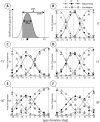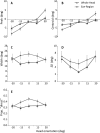Dual-route model of the effect of head orientation on perceived gaze direction
- PMID: 24730742
- PMCID: PMC4120707
- DOI: 10.1037/a0036151
Dual-route model of the effect of head orientation on perceived gaze direction
Abstract
Previous studies on gaze perception have identified 2 opposing effects of head orientation on perceived gaze direction-1 repulsive and the other attractive. However, the relationship between these 2 effects has remained unclear. By using a gaze categorization task, the current study examined the effect of head orientation on the perceived direction of gaze in a whole-head condition and an eye-region condition. We found that the perceived direction of gaze was generally biased in the opposite direction to head orientation (a repulsive effect). Importantly, the magnitude of the repulsive effect was more pronounced in the eye-region condition than in the whole-head condition. Based on these findings, we developed a dual-route model, which proposes that the 2 opposing effects of head orientation occur through 2 distinct routes. In the framework of this dual-route model, we explain and reconcile the findings from previous studies, and provide a functional account of attractive and repulsive effects and their interaction.
Figures












References
-
- Campbell R., Lawrence K., Mandy W., Mitra C., Jeyakuma L., & Skuse D. (2006). Meanings in motion and faces: Developmental associations between the processing of intention from geometrical animations and gaze detection accuracy. Development and Psychopathology, 18, 99–118. doi:10.1017/S0954579406060068 - DOI - PubMed
Publication types
MeSH terms
Grants and funding
LinkOut - more resources
Full Text Sources
Other Literature Sources

